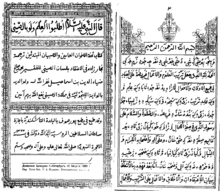
Back كتابة عربية صينية Arabic شياورجن ARZ Xiao’erjing German Xiao'erjing Spanish شیائو جینگ FA Xiao'erjing French श्याओ'अरजिंग HI Hsziaoercsing Hungarian Xiao'erjing ID Xiao'erjing Italian
| Xiao'erjing | |||||||||||||||
|---|---|---|---|---|---|---|---|---|---|---|---|---|---|---|---|
 A Chinese–Arabic–Xiao'erjing dictionary | |||||||||||||||
| Traditional Chinese | 小兒經 | ||||||||||||||
| Simplified Chinese | 小儿经 | ||||||||||||||
| Xiao'erjing | [1] ثِیَوْعَرݣٍْ | ||||||||||||||
| Literal meaning | children's script | ||||||||||||||
| |||||||||||||||
| Xiaojing | |||||||||||||||
| Traditional Chinese | 小經 | ||||||||||||||
| Simplified Chinese | 小经 | ||||||||||||||
| Literal meaning | minor script | ||||||||||||||
| |||||||||||||||
| Xiaojing | |||||||||||||||
| Traditional Chinese | 消經 | ||||||||||||||
| Simplified Chinese | 消经 | ||||||||||||||
| Xiao'erjing | [1] ثِیَوْݣٍْ | ||||||||||||||
| Literal meaning | revised script | ||||||||||||||
| |||||||||||||||
| Transliteration of Chinese |
|---|
| Mandarin |
| Wu |
| Yue |
| Min |
| Gan |
| Hakka |
| Xiang |
| Polylectal |
| See also |
| Part of a series on Islam in China |
|---|
 |
|
|


Xiao'erjing (lit. 'children's script'), often shortened to Xiaojing (lit. 'minor script', the 'original script'[a] being the Perso-Arabic script), is a Perso-Arabic script used to write Sinitic languages, including Lanyin Mandarin, Zhongyuan Mandarin, Northeastern Mandarin, and Dungan.[2][3][4][5] It is used on occasion by many ethnic minorities who adhere to Islam in China—mostly the Hui, but also the Dongxiang and the Salar—and formerly by their Dungan descendants in Central Asia. Orthographic reforms introduced the Latin script and later the Cyrillic script to the Dungan language, which continue to be used today.
Xiao'erjing is written from right to left, like other Perso-Arabic writing systems.
Xiao'erjing is unusual among Arabic script-based writing systems in that all vowels, long and short, are explicitly notated with diacritics, making it an abugida. Some other Arabic-based writing systems in China, such as the Uyghur Arabic alphabet, use letters and not diacritics to mark short vowels.
- ^ a b Sobieroj, Florian. (2019) "Standardisation in Manuscripts written in Sino-Arabic Scripts and xiaojing". Creating Standards: Interactions with Arabic script in 12 manuscript cultures, edited by Dmitry Bondarev, Alessandro Gori and Lameen Souag, Berlin, Boston: De Gruyter, pp. 177–216. https://doi.org/10.1515/9783110639063-008
- ^ Michael Dillon (1999). China's Muslim Hui community: migration, settlement and sects. Richmond: Curzon Press. p. 155. ISBN 0-7007-1026-4. Retrieved 2010-06-28.
- ^ Howard Yuen Fung Choy (2008). Remapping the past: fictions of history in Deng's China, 1979–1997. Brill. p. 92. ISBN 978-90-04-16704-9. Retrieved 2010-11-30.
- ^ Daftar-i Muṭālaʻāt-i Siyāsī va Bayn al-Milalī (Iran) (2000). The Iranian Journal of International Affairs. Vol. 12. Institute for Political and International Studies. p. 52. Retrieved 2010-11-30.
- ^ Centre for the Study of Religion and Communism (2003). Religion in Communist Lands. Vol. 31. Centre for the Study of Religion and Communism. p. 13. Retrieved 2010-11-30.
Cite error: There are <ref group=lower-alpha> tags or {{efn}} templates on this page, but the references will not show without a {{reflist|group=lower-alpha}} template or {{notelist}} template (see the help page).